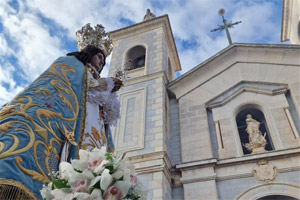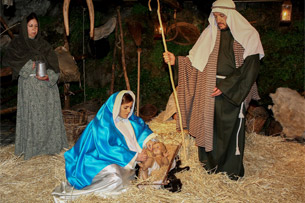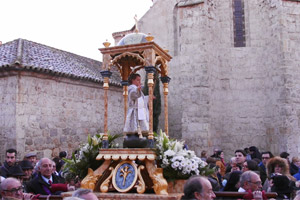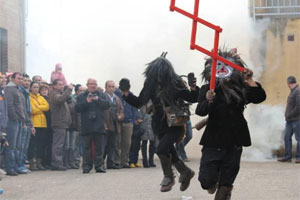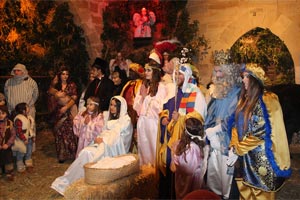Corpus Christi in Toledo
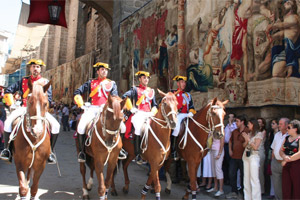
What is Corpus Christi in Toledo
The annual celebration of Corpus Christi in Toledo, Spain, is a significant event among believers throughout the country. This Eucharistic festival, recognized as an International Tourist Interest since 1980, has been part of Toledo's tradition since 1595. The procession takes place on the Thursday following the eighth Sunday after Easter and holds a rich history and literary participation.
The solemnity of Corpus Christi in Toledo has been immortalized in literary works such as Benito Pérez Galdós' "La catedral" and is considered a symbol of decadence in Vicente Blasco Ibáñez's "La catedral." These writers describe the profound influence the festival has on the life of the cathedral and Toledo's society. The most significant and splendid object of the procession is the Custodia created by Enrique de Arfe in the 16th century, which parades through the adorned streets of Toledo and marks the highlight of the celebration.
The city of Toledo meticulously prepares for the Corpus Christi procession. Historical awnings from the weavers' and silk-makers' guilds cover the streets along the route, while balconies of houses are adorned with tapestries, flags, and other ornaments. Even adjacent streets and private courtyards are specially decorated for the event. In addition, parades take place, and fragrant plants line the route, creating a festive atmosphere throughout the city.
Corpus Christi day begins early with reveille and the firing of royal bombs to announce the start of the procession. As the procession moves through the narrow and picturesque streets of Toledo, awnings are unfurled to protect the Sacred Host, and the streets are adorned with lights, flowers, and colorful fabrics. The crowd gathers at every corner and balcony to witness the passage of the procession, while the fragrant aroma of herbs fills the air.
The collaboration of religious and civic institutions, along with the Corpus Christi Board, has been essential in ensuring that everything is ready for this grand celebration. The historical significance, deep-rooted traditions, art, spirituality, and joy intertwine in Corpus Christi in Toledo, making it a unique and vibrant event that continues to attract the attention and fervor of believers and visitors from around the world.
La Custodia
The Custodia of Corpus Christi is the central element of the procession in Toledo. This highly valuable object is located in the Treasury Chapel of the city's cathedral. Crafted by the goldsmith Enrique de Arfe in the 16th century, this custodia in a neo-Gothic style is a beautifully designed architectural masterpiece. Originally made of silver, it was later gilded to match the gilded wooden custodia of the high altar. The creation of the custodia took seven years and its cost exceeded fifteen million maravedíes.
The custodia was commissioned by the Chapter of the Cathedral of Toledo and is used to house the golden ostensorium, known as the "small custodia," which belonged to Queen Isabella the Catholic and is said to have been crafted with the first gold from America. This impressive custodia measures 309.5 cm in height and is made of gilded silver. It has the shape of a hexagonal Gothic tower and rests on a silver pedestal with overlaid bronze. It is adorned with bundled columns, pinnacles, heraldic shields, and chambranles.
During the procession, the custodia is transported in a specially designed carriage that automatically adjusts to the steep slopes of the city. Accompanied by ecclesiastical and civil authorities, and escorted by cadets from the Infantry Academy, the custodia receives constant applause and admiration from the crowd.
The procession
The procession takes place in two parts, each with different groups and symbols. In the first part, the most recent brotherhoods, chapters, and guilds parade, following a protocol and order established by ancient rules and traditions. The procession begins with a 16th-century processional cross and continues with different groups, such as the Infanzones of Illescas, the Mozarabic Knights, the Knights of the Holy Sepulchre, and the Knights of Corpus Christi, each with their respective attire and representative symbols.
In the second part of the procession, the regular and secular clergy, the primatial chapter, and the Arfe custodia stand out. The Primate Archbishop with his entourage follows, and then the regional, provincial, local, and military authorities. This part of the procession is marked by the presence of figures of authority and represents an important moment in the route.
The procession follows an established protocol and order. Each group wears their characteristic attire and symbols, adding a special meaning to this traditional and religious event.
Origin and History
The Corpus Christi procession in Toledo is a religious festivity that complies with the provisions of Pope Urban IV, who decreed in 1262 the celebration of processions with the consecrated Host to allow believers to express their faith. What began as processions limited to the temples soon expanded to the streets, awakening popular devotion and the participation of believers from all walks of life, including religious, civil, and even military individuals.
In Toledo, the city and its inhabitants wholeheartedly embrace this festivity since 1342, aiming for the presence and participation of all to be as splendid as possible. The streets are adorned, and the procession takes place under the presidency of the Archbishop, following the directions of the Cathedral Chapter responsible for the order and protocol. Over 60 different groups, including brotherhoods, fraternities, institutions, and public and private corporations, participate in the event, accompanied by civilian and military music bands. People from all parishes and even distant places come to express their devotion.
Present Day
The Corpus Christi celebration begins early with reveille and the firing of royal bombs, followed by the parade of the Tarasca accompanied by the street band, giants, and big-heads. The military garrison deploys along the procession route to cover the procession, which departs from the cathedral at 11 in the morning, announced by a salute of mortars. The procession maintains the traditional order and distribution, and in recent years, a group of children receiving their First Communion has been incorporated behind the guilds.
Originally, the Corpus procession was held on Thursdays, but in 1991, it was moved to the following Sunday due to an agreement between the Church and the State to reorganize the work calendar. However, in 2004, on the occasion of the National Eucharistic Congress in Toledo, the celebration of two processions each year was established, one on Thursday for tradition, and another on Sunday for the liturgical feast of Corpus Christi. This duality remained until 2010 when the Primate Archbishop reinstated the procession on the day of Corpus Christi according to the Hispanic-Mozarabic liturgical calendar, which is the traditional Thursday. In that same year, the presence of the national flag in the honor guard of the Toledo Infantry Academy was removed due to the implementation of a new Regulation of Military Honors.
What to see in Toledo
Toledo, known as the "Imperial City" or the "City of Three Cultures," offers a wide variety of tourist and cultural attractions that reflect its rich history and cultural heritage. Here are some of the main things to see and do in Toledo:
- The Toledo Cathedral: It is a masterpiece of Gothic art and one of the city's main attractions. Its impressive architecture, stained glass windows, and artworks make it a must-visit.
- The Alcázar of Toledo: Located atop a hill, this fortified palace offers panoramic views of the city. It currently houses the Army Museum, which displays an extensive collection of armor, weapons, and military artifacts.
- The Old Town: Strolling through the narrow streets of Toledo's old town is like stepping into the past. Discover medieval architecture, charming courtyards and squares, and visit the Church of Santo Tomé, where the famous painting "The Burial of the Count of Orgaz" by El Greco is located.
- The Monastery of San Juan de los Reyes: This Franciscan monastery stands out for its beautiful cloister and ornate facade. It is a peaceful and serene place worth visiting.
- The Synagogue of Santa María La Blanca: A testimony to the coexistence of Jewish, Muslim, and Christian cultures in Toledo. This synagogue is characterized by its Mudéjar architecture and magnificent ornamental details.
- The Greco Museum: Located in the former house of the famous Spanish painter El Greco, the museum houses a collection of his masterpieces, as well as other artworks related to the period in which he lived.
- The San Martín Bridge: This medieval bridge over the Tagus River is an icon of Toledo. Take a leisurely walk across the bridge and enjoy the views of the river and the city.
- The Baths of Cenizal: These ancient Arab baths are a testament to the Muslim influence in Toledo. Explore the different rooms and admire the architecture and details.
These are just a few of the many places you can visit in Toledo. The city is also famous for its craftsmanship, especially the production of swords and damascening. Enjoy the delicious local cuisine and immerse yourself in the history and culture of this charming Spanish city.
Recommended Crafts and Shopping
Toledo is known for its rich artisanal tradition, and there are several shopping options that will allow you to take home unique and authentic pieces. Here are some recommendations for crafts and shopping in Toledo:
- Swords and armor: Toledo is famous for the production of high-quality swords and armor. You can find specialized shops where you can acquire historical replicas as well as decorative swords and other items related to medieval culture.
- Damascening: This artisanal technique involves inlaying gold or silver threads into metal objects, creating intricate designs and patterns. Damascening is a traditional art in Toledo, and you can find jewelry, boxes, knives, and other decorative objects crafted with this technique.
- Ceramics and tiles: Toledo is also known for its hand-painted ceramics and tiles. You can find plates, vases, decorative tiles, and other ceramic objects with traditional or contemporary designs.
- Leather goods: Leatherwork is another specialty of Toledo. Find shops that offer handmade leather products such as bags, belts, wallets, and other high-quality leather accessories.
- Bobbin lace: Bobbin lace is an artisanal technique used to create beautiful lacework and lace trimmings. In Toledo, you can find products made with this technique, such as tablecloths, handkerchiefs, and lace accessories.
- Woodcraft: There are workshops and stores in Toledo where hand-carved wooden products are made, such as mirror frames, boxes, decorative figures, and furniture.
Remember, when making your purchases, it is important to ensure that you are acquiring authentic and quality products. Look for shops and workshops that are recognized for their traditional craftsmanship and have the endorsement of local artisans.
Enjoy exploring Toledo's craftsmanship and take home unique souvenirs that reflect the tradition and artistic talent of the city.
What to eat in Toledo
The typical gastronomy of Toledo is a delight for food lovers. Here are some options of popular dishes you must try during your visit:
- Manchego Shepherd's Migas: Manchego Shepherd's Migas is a traditional dish from the La Mancha region. It is prepared with crumbled stale bread, garlic, bacon or chorizo, olive oil, green bell pepper, and salt. The bread is soaked and fried with the oil and garlic to create a crispy exterior and a soft interior texture. The flavor stands out due to the combination of ingredients, which impart a smoky and spicy touch, thanks to the chorizo or bacon. It is served hot, and in some places, it is often accompanied by grapes or oranges for a contrast of flavors. Manchego Shepherd's Migas is a delicious, rustic, and comforting dish with an authentic taste of La Mancha's cuisine.
- Roast lamb: Roast lamb is one of the most emblematic dishes of Toledo's cuisine. Prepared with suckling lamb and seasoned with spices and herbs, it is slowly cooked in a wood-fired oven to obtain tender and juicy meat.
- Carcamusas: This traditional dish consists of a stew made with pork meat and vegetables such as tomato, peas, and carrots. It is a comforting and flavorful option that is usually served with French fries.
- Stewed partridge: Stewed partridge is another classic dish of Toledo. The partridge meat is slowly cooked in a sauté of onion, garlic, wine, and spices, giving it an intense and aromatic flavor.
- Pisto Manchego: Originally from the La Mancha region, Pisto Manchego is a popular vegetarian dish in Toledo. It is a stew of vegetables such as tomato, bell peppers, zucchini, and eggplant, seasoned with herbs and spices.
- Mazapán: Mazapán is a typical sweet from Toledo that you must try. Made with ground almonds, sugar, and egg, it is molded into different shapes and decorated with vibrant colors. It is a sweet and delicious treat that is often enjoyed during festivities.
- Manchego cheese: If you are a cheese lover, you cannot miss trying Manchego cheese during your visit to Toledo. This sheep's milk cheese has a firm texture and a mild, slightly spicy flavor. It is perfect to enjoy with some bread and accompanied by local wine.
The city offers a wide variety of local dishes and products, as well as bars and restaurants that will allow you to explore and enjoy the rich culinary tradition of the region.

